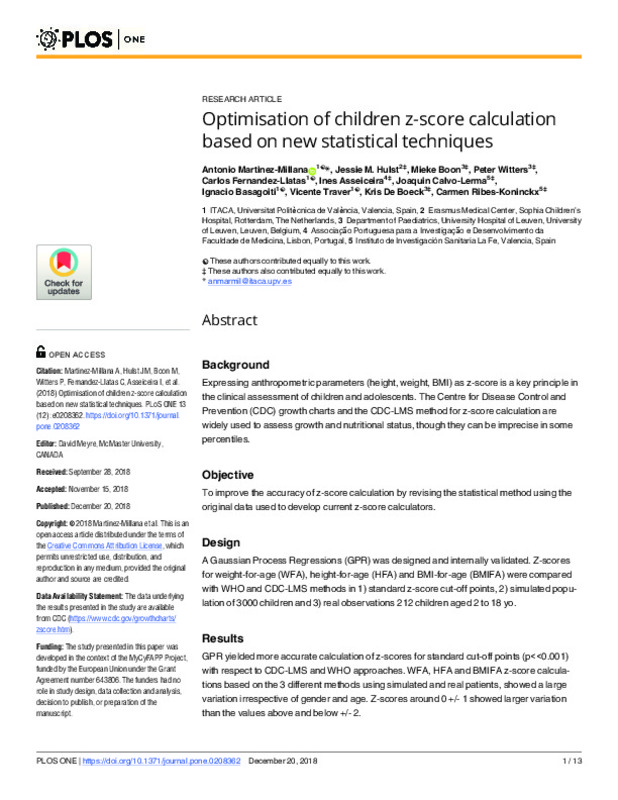JavaScript is disabled for your browser. Some features of this site may not work without it.
Buscar en RiuNet
Listar
Mi cuenta
Estadísticas
Ayuda RiuNet
Admin. UPV
Optimisation of children z-score calculation based on new statistical techniques
Mostrar el registro sencillo del ítem
Ficheros en el ítem
| dc.contributor.author | Martinez-Millana, Antonio
|
es_ES |
| dc.contributor.author | Hulst, Jessie M.
|
es_ES |
| dc.contributor.author | Boon, Mieke
|
es_ES |
| dc.contributor.author | Witters, Peter Witters
|
es_ES |
| dc.contributor.author | Fernández Llatas, Carlos
|
es_ES |
| dc.contributor.author | Asseiceira, Ines
|
es_ES |
| dc.contributor.author | Calvo-Lerma, Joaquim
|
es_ES |
| dc.contributor.author | Basagoiti, Ignacio
|
es_ES |
| dc.contributor.author | Traver Salcedo, Vicente
|
es_ES |
| dc.contributor.author | De Boeck, Kris
|
es_ES |
| dc.contributor.author | Ribes-Coninckx, Carmen
|
es_ES |
| dc.date.accessioned | 2019-09-27T07:56:51Z | |
| dc.date.available | 2019-09-27T07:56:51Z | |
| dc.date.issued | 2018 | es_ES |
| dc.identifier.issn | 1932-6203 | es_ES |
| dc.identifier.uri | http://hdl.handle.net/10251/126486 | |
| dc.description.abstract | [EN] Background Expressing anthropometric parameters (height, weight, BMI) as z-score is a key principle in the clinical assessment of children and adolescents. The Centre for Disease Control and Prevention (CDC) growth charts and the CDC-LMS method for z-score calculation are widely used to assess growth and nutritional status, though they can be imprecise in some percentiles. Objective To improve the accuracy of z-score calculation by revising the statistical method using the original data used to develop current z-score calculators. Design A Gaussian Process Regressions (GPR) was designed and internally validated. Z-scores for weight-for-age (WFA), height-for-age (HFA) and BMI-for-age (BMIFA) were compared with WHO and CDC-LMS methods in 1) standard z-score cut-off points, 2) simulated population of 3000 children and 3) real observations 212 children aged 2 to 18 yo. Results GPR yielded more accurate calculation of z-scores for standard cut-off points (p<<0.001) with respect to CDC-LMS and WHO approaches. WFA, HFA and BMIFA z-score calculations based on the 3 different methods using simulated and real patients, showed a large variation irrespective of gender and age. Z-scores around 0 +/- 1 showed larger variation than the values above and below +/- 2. Conclusion The revised z-score calculation method was more accurate than CDC-LMS and WHO methods for standard cut-off points. On simulated and real data, GPR based calculation provides more accurate z-score determinations, and thus, a better classification of patients below and above cut-off points. Statisticians and clinicians should consider the potential benefits of updating their calculation method for an accurate z-score determination. | es_ES |
| dc.description.sponsorship | The study presented in this paper was developed in the context of the MyCyFAPP Project, funded by the European Union under the Grant Agreement number 643806. The funders had no role in study design, data collection and analysis, decision to publish, or preparation of the manuscript. | es_ES |
| dc.language | Inglés | es_ES |
| dc.publisher | Public Library of Science | es_ES |
| dc.relation.ispartof | PLoS ONE | es_ES |
| dc.rights | Reconocimiento (by) | es_ES |
| dc.subject.classification | TECNOLOGIA ELECTRONICA | es_ES |
| dc.subject.classification | TECNOLOGIA DE ALIMENTOS | es_ES |
| dc.title | Optimisation of children z-score calculation based on new statistical techniques | es_ES |
| dc.type | Artículo | es_ES |
| dc.identifier.doi | 10.1371/journal.pone.0208362 | es_ES |
| dc.relation.projectID | info:eu-repo/grantAgreement/EC/H2020/643806/EU/Innovative approach for self-management and social welfare of Cystic Fibrosis patients in Europe: development, validation and implementation of a telematics tool./ | es_ES |
| dc.rights.accessRights | Abierto | es_ES |
| dc.contributor.affiliation | Universitat Politècnica de València. Departamento de Ingeniería Electrónica - Departament d'Enginyeria Electrònica | es_ES |
| dc.contributor.affiliation | Universitat Politècnica de València. Instituto Universitario de Ingeniería de Alimentos para el Desarrollo - Institut Universitari d'Enginyeria d'Aliments per al Desenvolupament | es_ES |
| dc.description.bibliographicCitation | Martinez-Millana, A.; Hulst, JM.; Boon, M.; Witters, PW.; Fernández Llatas, C.; Asseiceira, I.; Calvo-Lerma, J.... (2018). Optimisation of children z-score calculation based on new statistical techniques. PLoS ONE. 13(12). https://doi.org/10.1371/journal.pone.0208362 | es_ES |
| dc.description.accrualMethod | S | es_ES |
| dc.relation.publisherversion | https://doi.org/10.1371/journal.pone.0208362 | es_ES |
| dc.type.version | info:eu-repo/semantics/publishedVersion | es_ES |
| dc.description.volume | 13 | es_ES |
| dc.description.issue | 12 | es_ES |
| dc.identifier.pmid | 30571681 | |
| dc.identifier.pmcid | PMC6301782 | |
| dc.relation.pasarela | S\374425 | es_ES |
| dc.contributor.funder | European Commission | es_ES |








